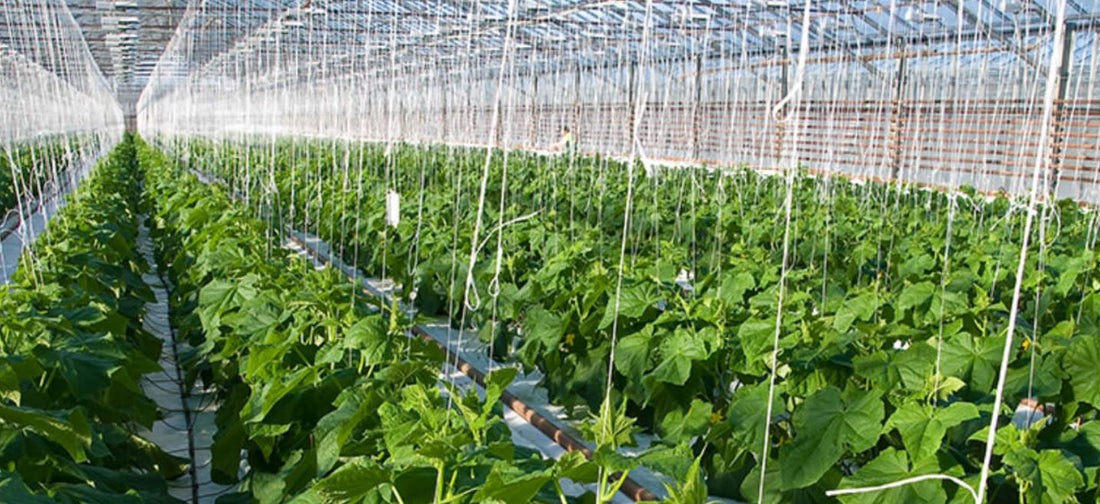
Faced with increasing weather unpredictably, many growers are erecting greenhouse structures to grow their crops and even raise animals. When combined with farm management software for highly efficient operations, new technology in greenhouse structures and controlled environment growing techniques represent a scalable solution to sustainable food production. No matter what the weather does.
This guide is meant to assist farm enterprises in mitigating weather limitations and managing and scaling their agricultural production using covered greenhouse structures.

How Does Weather Affect Farming?
Extreme weather events and even slightly shifting climate conditions hurt agricultural production.
Adverse weather conditions and climate disasters in 2021 left U.S. crop and livestock farmers reeling from in production loss. Rising temperature extremes between 1991 and 2017 caused farm insurance loss payouts to 27 billion.
Floods and droughts are the most immediately impactful weather events, typically causing direct production losses. However, weather conditions impact farming in many less obvious or secondary ways.
For instance, a persistent wet and cool spring may not result in flooding but still prevents a farmer from being able to plant their crops when they normally do in the spring. Or, wet conditions may negatively affect critical early plant growth and stress young plants, leaving them susceptible to disease outbreaks and pest predation. Early fall cold snaps may kill a crop before it reaches maturity, while overly hot temperatures during the growing season can severely affect crop growth.
And it’s not just crops. Livestock production is also affected by extreme weather events; drought is particularly tough on the cattle industry because it severely restricts the growth of grasses and forages for pasture grazing. But even small livestock, like chickens for eggs and meat production, are susceptible to temperature extremes.
The most significant advantage of greenhouse farming is the ability to control the greenhouse environment and greenhouse temperatures to support the growth of high-quality crops, even on a year-round cycle.
Climate Change, Sustainability and Greenhouse Farming
While extreme weather conditions have always been part of farming, global warming caused by increasing greenhouse gases in our atmosphere is contributing to more frequent and extreme unfavorable weather events and threatening global food security.
According to united nations the planet is averaging 1.1 degrees Celsius above pre-industrial temperatures. While that may not seem like a lot, increased air temperatures change traditional weather patterns, causing more catastrophic heat waves, extreme precipitation events and other weather-induced events, like rising sea levels from melting glaciers. All these events make it harder for farmers to grow crops in traditional ways.
At the same time, agricultural production and farm practices contribute to the climate change problem. Traditional farming practices release carbon dioxide and other potent greenhouse gases like nitrous oxide and methane into the atmosphere. About one-third to one-quarter of the planet’s annual greenhouse gases are contributed to the food supply chain. Consumers and food supply companies are no beginning to demand a more sustainable food supply chain supporting healthy environments and ecosystems.
Essentially farmers and growers are both adversely affected by the problems resulting from climate change while also being part of the reason climate change is occurring in the first place.
Greenhouse farming is seen as one solution to the climate change problem.
Greenhouse structures can mitigate high and low temperatures while growing food in regions where food production wasn’t previously possible, thereby reducing carbon emissions due to transportation, lessening the impact of supply chain shocks, and conserving water and nutrient use as compared to traditional agricultural production. Also, growers can produce a larger volume of food in a smaller greenhouse space than outdoor production models, reducing the pressures to convert forests and prairies into farmland and maintain those ecosystems as critical carbon sinks.
Controlled Environment Agriculture Versus Greenhouse Farming
Controlled environment agriculture (CEA) and greenhouse farming are interchangeable terms. However, they have some key differences.
CEA controls all aspects of growing, including temperature, humidity, sunlight, water, nutrition and even the planting material (aka soil). A CEA grow is entirely indoors, like in a warehouse, uses a soilless method of growing and utilizes LED lighting to simulate sunlight and induce photosynthesis. But a major disadvantage of CEA is the high electricity costs to operate the LED lighting system.
Greenhouses are a type of CEA but also take advantage of natural sunlight by covering the structure with some see-through material, such as vinyl polyethylene, polycarbonate, fiberglass or glass. Depending on the style of greenhouse, all the components seen in a CEA grow can also be incorporated into a greenhouse farming operation. There are even hydroponic farmers operating out of greenhouse structures.
The big advantage of greenhouses is their ability to offset their electricity costs by using natural sunlight as their primary light source in the greenhouse environment. Even so, some greenhouse structures also have LED lights included to provide additional lighting beyond natural sunlight during times of the year when natural sunlight is limited.


